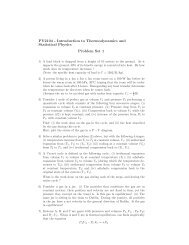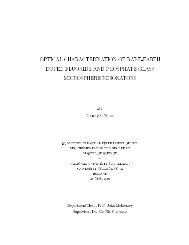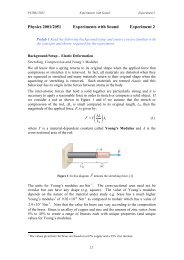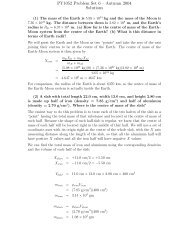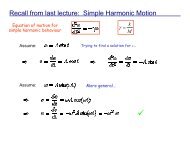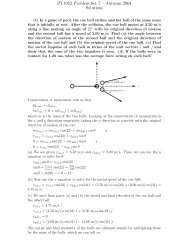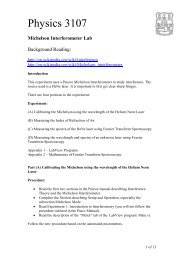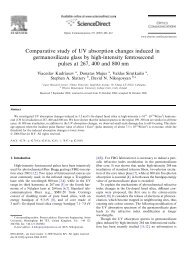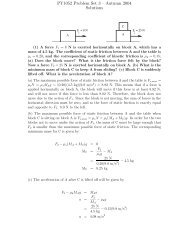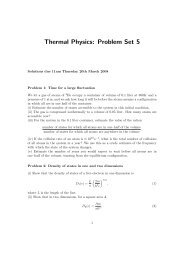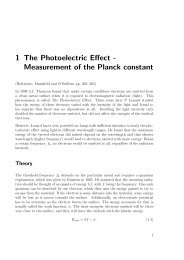PY1052 Problem Set 8 â Autumn 2004 Solutions
PY1052 Problem Set 8 â Autumn 2004 Solutions
PY1052 Problem Set 8 â Autumn 2004 Solutions
You also want an ePaper? Increase the reach of your titles
YUMPU automatically turns print PDFs into web optimized ePapers that Google loves.
PE i + KE i = PE f + KE fMgh i + 0 = Mgh f + 1 2 Iω212 Iω2 = Mg(h i − h f )12 [11 12 MR2 ]ω 2 = Mg(h i − h f )ω 2 = 24g(h i − h f )√11R 224g(hi − h f )ω =11R 2=√ 24(9.8 m/s2 )(0.050 m)11(0.10 m) 2ω = 10.3 rad/s(3) A hoop rolls down a ramp. (a) What must be the inclination of the rampin order for the translational acceleration of the center of the hoop to have amagnitude of 0.10g? (b) If a frictionless block were to slide down the incline tiltedat that same angle, would its acceleration be more than, less than or equal to0.10g? Explain why without actually calculating the acceleration of such a block.(a) We derived in class an expression for the translational acceleration of an object rollingdown an incline (it is also given on p. 250 of Halliday, Resnick & Walker):a com =g sin θ1 + I com /MR 2Here a com is the acceleration of the centre of mass down the ramp and I com is the moment ofinertia of the rolling object for rotation about an axis passing through its centre of mass. Inthe case of a hoop, this is I com = MR 2 . We can now find the needed inclination of the ramp:a com =a com = 1 2 g sin θg sin θ1 + MR 2 /MR 2sin θ = 2a comgsin θ = 2(0.10g)gθ = 11.5 ◦= 0.20(b) The acceleration of the block would be greater than that of the hoop. The reason is thatthe acceleration comes about due to a transformation of the initial gravitational potentialenergy of the object going down the ramp into kinetic energy. In the case of both the blockand the hoop, the same amount of gravitational potential energy is transformed into kineticenergy – in the case of the block, all of the kinetic energy that is gained is translational, but inthe case of the hoop, some of the kinetic energy that is gained is rotational, which means thatthe hoop has less translational kinetic energy after going the same distance down the ramp.
(4) A 3.0 kg object with velocity ⃗v = (5.0 m/s)î−(6.0 m/s)ĵ is located at x = 3.0 m,y = 8.0 m and experiences a force F = 7.0 N acting in the negative x direction. (a)What is the angular momentum of the object about the origin? (b) What torqueabout the origin acts on the particle due to F ⃗ ? (c) At what rate is the angularmomentum of the particle changing with time?yy = +8Fvrα = atan(8/3) = 69 degFαβx = +3xvβ = atan(6/5) = 50 deg(a) The diagram shows the object, its velocity and the force acting on it. The object’smomentum is in the same direction as its velocity, and is equal to ⃗p = m⃗v. The angularmomentum of the object about the origin will be (φ is the angle between ⃗r and ⃗p)⃗L = ⃗r × ⃗pL = rp sin φ = rp sin(α + β)√r = (3.0 m) 2 + (8.0 m) 2 = 8.54 m√v = (5.0 m/s) 2 + (−6.0 m/s) 2 = 7.81 m/sL = (8.54 m)[(3.0 kg)(7.81 m/s)] sin(119)L = 175 kg m 2 /sThe direction of the angular momentum is given by the right-hand rule, and is into the page.(b) The torque exerted by the force ⃗ F is⃗τ = ⃗r × ⃗ Fτ = rF sin φ = rF sin(180 − α)τ = (8.54 m)(7.0 N)(sin(111)τ = 55.8 N mThe direction of the torque is given by the right-hand rule, and is out of the page.(c) The rate at which the angular momentum of the particle is changing with time is given bydLdt= τ = 55.8 N m(5) A sanding disk with moment of inertia I = 1.2×10 −3 kg m 2 is attached to anelectric drill whose motor exerts a constant torque of τ = 16 N m. What are (a)the angular momentum of the disk about its central axis 33 ms after the motoris turned on and (b) the angular speed of the disk at this same time?(a) The angular momentum of the disk will be given by the expressions τ = ∆L/∆t or L = Iω;the first of these is easier to use based on the information given:∆L = τ∆tL − 0 = (16 N m)(33 × 10 −3 s)L = 0.53 N m s = 0.53 J s
L i = L fmv i r i = mv f r fv f = v ir ir fv f = (3.50 m/s) 0.5000.400= 4.38 m/s(d) We can now find the mass M 2 using the same approach as in part (a)T − (M 1 + M 2 )g = 0mv 2− (M 1 + M 2 )gr= 0M 2 = mv2rg − M 1M 2 =(0.200 kg)(4.38 m/s)2(0.400 m)(9.8 m/s 2 )M 2 = 0.479 kg− 0.500 kg(7) A wheel with a moment of inertia I is rotating freely at an angular speed of800 rev/min on an axle with negligible moment of inertia. A second wheel withmoment of inertia 2I that is initially at rest is then suddenly coupled to the sameaxle, so that it also rotates. (a) What is the angular speed of the combinationof the two wheels rotating about the axle? (b) What fraction of the originalrotational kinetic energy is lost?(a) The key is that the angular momentum of the two wheels is conserved when they arecoupled:L before = L afterI 1i ω 1i + I 2i ω 2i = I 1f ω 1f + I 2f ω 2fIω 1i + 2I(0) = (I + 2I)ω fω f = ω 1i3(b) The kinetic energy that is lost is given by∆KE = KE before − KE after= 267 rev/min= ( 1 2 I 1ω 2 1i + 1 2 I 2(0) 2 ) − 1 2 I fω 2 f= 1 2 Iω2 1i − 1 2 (3I)ω2 fand the fraction that is lost is given by∆KEKE i=12 Iω2 1i − 1 2 (3I)ω2 f12 Iω2 1i= ω2 1i − 3ω 2 fω 2 1i= (800 rev/min)2 − 3(267 rev/min) 2(800 rev/min) 2= 0.6666% of the initial kinetic energy is lost when the wheels are coupled.
m = 1.5 kg m = 2.0 kg1 2M = 4.0 kg(8) A board is balanced as is shown above. m 1 and m 2 are x 1 = 2.5 m andx 2 = 1.2 m to the left of the support point, which is just under the centre of theboard. How far is M from the support point?We have three conditions for the equilibrium:∑ ∑ ∑ Fx = 0 Fy = 0 τ = 0In this case, there are no horizontal forces, so we only have the last two of these equations.(i) ∑ F y = 0F support + m 1 g + m 2 g + Mg + m board g = 0where F support is the upward force of the support and m board is the mass of the board (whichwe do not know).(ii) ∑ τ = 0We can choose any point about which to take the torques. It is convenient in this case tochoose the centre of the board as the point about which we take our torques. The reason isthat if we choose any other point, we will get a torque equation that has three unknowns:F support , m board and X, where X is the distance from the support to the mass M. This meansthat we’ll have two equations with three unknowns, since we are not given the mass of theboard. If we take torques about the centre of the board, neither the weight of the board norF support exert torques, and the only unknown in our torque equation will be X:∑ τ = m1 gx 1 sin(90) + m 2 gx 2 sin(90) − MgX sin(90) = 0X = m 1x 1 +m 2 x 2= 0M(1.5 kg)(2.5 m)+(2.0 kg)(1.2 m)X = = 1.54 m4.0 kg(1b) A bowler throws a bowling ball of radius R = 11 cm along a lane. Theball slides on the lane with an initial speed v 0 = 8.5 m/s and initial angular speedω 0 = 0. The coefficient of kinetic friction between the ball and lane is µ k = 0.21.The kinetic friction force acting on the ball causes a linear acceleration of theball while also producing a torque that causes an angular acceleration of the ball.When the speed v has decreased enough and the angular speed ω has increasedenough, the ball stops sliding and then rolls smoothly. (a) What then is v interms of ω? (b) During the sliding, what are the ball’s translational and angularacceleration? (c) How far does the ball slide?(a) When the ball has slowed down enough to roll smoothly, the linear and angular velocitiesmust be related by the usual formula for smooth rolling: v = Rω.(b) The ball’s translational acceleration is given by∑F = ma−µ k N = −µ k mg = ma−µ k g = a
where N is the normal force and m is the mass of the bowling ball.acceleration is given byThe ball’s angular∑τ = Iαµ k NR = µ k mgR = [ 2 5 mR2 ]α5µ k g2R = αHere, τ = RF k sin φ, where F k is the force of kinetic friction and φ is the angle between theradius vector to the point where the force of kinetic friction acts and the direction of F k , whichis 90 ◦ .(c) We can find how far the ball slides by first finding v using a and finding ω using α, thenfinding the time the ball slides by setting v = Rω :v = v i + at= v i − µ k gt slideω = ω i + αt= 5µ kg2R t slide (ω i = 0)v i − µ k gt slide = R( 5µ kg2R t slide)= (µ k g + 5 2 µ kg)t slide = 7 2 µ kgt slidet slide = 2 v i7 µ k g = 2 8.5 m/s7 (0.21)(9.8 m/s 2 ) = 1.18 sThe distance the ball slides is then given byd = v i t + 1 2 at2= v i t − µ kg2 t2 slide= (8.5 m/s)(1.18 s) − (0.21)(9.8 m/s2 )(1.18 s) 2 = 8.60 m2Putty¡¢¡¢¡¢¢¡¢¡¢¡ ¢¡¢¡¢¡ ¢¡¢¡¢¡ ¢¡¢¡¢¡ ¢¡¢¡¢Rotation axis(2b) Two 2.00 kg balls are attached to the ends of a thin rod of negligible massthat is 50.0 cm long. The rod is free to rotate in a vertical plane without frictionabout a horizontal axis through its centre. With the rod initially horizontal, a50.0 g wad of putty drops onto one of the balls, hitting it with a speed of 3.00 m/sand sticking to it. (a) What is the angular speed of the system just after the puttyhits? (b) What is the ratio of the kinetic energy of the system after the collisionto that of the putty just before the collision? (c) Through what angle will thesystem rotate until it momentarily stops?
(a) The angular momentum of the rod+balls+putty will be conserved in this inelastic collision.Just before the collision, all the angular momentum belongs to the putty. To find this initialangular momentum, we need to choose a point about which we will calculate the angularmomentum – I chose the point about which the rod can rotate, i.e., the centre of the rod. Theinitial angular momentum of the falling putty is then£¤£¤¦¥¦¥L i = r putty p putty sin φ = r putty m putty v putty sin φ= (0.250 m)(0.0500 kg)(3.00 m/s) sin(90)= 0.03750 kg m 2 /sHere, φ is the angle between ⃗r and ⃗p:rputty¨¡¨¡¨ §¡§¡§¨¡¨¡¨ §¡§¡§pRotation axisThe angular momentum after the collision will be L f = Iω, where I is the total moment ofinertia for the balls and putty. Treating the two balls like point masses:I f = 2[M ball R 2 ] + m putty R 2 = [4M ball + m putty ]R 2= [4(2.0 kg) + 0.050 kg](0.250 m) 2 ] = 0.503 kg m 2L i = L fr putty m putty v putty = I f ω f0.0375 kg m 2 /s = (0.503 kg m 2 )ω fω f = 0.0746 rad/s(b) The kinetic energy before the collision is purely due to the putty:KE i = 1 2 m puttyv 2 putty = 1 2 (0.050 kg)(3.00 m/s)2 = 0.225 JThe kinetic energy just after the collision isKE f = 1 2 Iω2 = 1 2 (0.503 kg m2 )(0.0746 rad/s) 2 = 0.00140 JThus, the ratio of the kinetic energies just after and just before the collision isKE f /KE i = 0.00140 J/0.225 J = 0.00622In other words, about 99.4% of the initial kinetic energy is lost.(c) The rod will momentarily stop when it gets to a point where all its initial kinetic energy hasbeen transformed into gravitational potential energy. We can choose any height for h = 0, solet’s choose the initial horizontal height of the two balls. When the balls are not horizontal, onewill have a gravitational potential energy of +mgh, while the other will have a gravitationalPE of mg(−h) = −mgh. The sum of these two is obviously zero, just as it was before the puttyhit. This will always be true - the gravitational potential energies of the two balls will alwaysadd to zero. Therefore, it is the mass and height of the putty that will determine where therod stops. The system will accelerate as it swings downwards, attaining its maximum speedwhen the putty is at the bottom. The maximum height attained by the putty will be givenbym putty gh max = 1 2 Iω2h max =1(m putty g )(1 2 Iω2 )=1((0.050 kg)(9.8 m/s 2 (0.00140 J))h max = 0.00286 m = 2.86 mm
©h max¡ ¡¡¡¡ ¡ ©Therefore, the angle through which the system swings before it momentarily stops is 180 ◦ plusarcsin(0.00286/0.25) = 180.66 ◦ .La 1a 2a 3a 4(3b) Four identical bricks of length L are stacked on top of one another asshown, such that part of each extends beyond the one beneath. Find in terms ofL the maximum values of the overhangs a 1 , a 2 , a 3 , a 4 , and h such that the stack isin equilibrium.It may seem odd, but the best way to go about this is to start at the top and work our waydown. Looking at the top brick, in order for it to be in equilibrium, there must be no net forceand no net torque acting on it. If we imagine starting with the top brick so that its right sideis flush with the right side of the brick below, then slowly moving it over to the right, it canremain in equilibrium as long as its centre of mass is located over the brick below - as soonas its centre of mass moves out beyond the edge of the brick below, the top brick will feel anet torque and fall over. Therefore, the maximum distance for a 1 isa 1 = L/2.Now look at the top two bricks. They will fall if their centre of mass lies beyond the edge ofthe next brick down. So let’s find the centre of mass of the two top bricks. It is convenientto choose the right edge of the second brick down as x = 0. In this case, the centre of massof the two bricks will bex 2,com = m(0)+m(−L/2) = −L/42mwhere m is the mass of each of the bricks. The centre of mass of the top two bricks is adistance L/4 from the right edge of the second brick down so, and this is the furthest overthe bricks can be and be in equilibrium: a 2 = L/4.Now continue with the top three bricks, using the right edge of the third brick down as x = 0.The centre of mass of the third brick is located at x = −L/2 relative to its right-hand edge.The second brick’s centre of mass is located a distance L/4 to the left of the right-hand edgeof the third brick, or at x = −L/4. The centre of mass of the top brick is located a distancea 2 = L/4 to the right of the right-hand edge of the third brick, or at x = L/4. Therefore:x 3,com = m(−L/4)+m(L/4)+m(−L/2) = −L/63mThe centre of mass of the top three bricks is a distance L/6 from the right edge of the thirdbrick down so, and this is the furthest over the bricks can be and still be in equilibrium:a 3 = L/6.Carefully carrying out the same procedure for all four bricks yields a 4 = 1/8. Thus, themaximum value for h is h = a 1 + a 2 + a 3 + a 4 = 25L/24!Note that it is not necessary to calculate the COM positions for each brick separately as I didabove. Once you have the COM of the top two bricks, you can then subsequently treat themas a single object with mass 2m sitting at the location of the COM, and so forth.h




